Newsletter 2025 A NOTE FROM OUR CLINICAL DIRECTOR, JESS JOHNSON What a scorching Summer we’ve all had, bringing both brilliant sunshine and testing conditions. Our team have been busy supporting all our lovely patients with their summer activities. We’ve got a variety of exciting content for you this newsletter, including interesting articles; welcoming new arrivals to the Hampden’s family; community events and other highlights. We hope you all enjoy the last of the Summer and welcome the cooler Autumn weather OFFICE UPDATE We have an exciting update for you all regarding our office team. We have combined our Equine and Farm offices at our Glebe Close Farm site, near Wing. By combining forces into a Large Animal Office, we’ve created a strong, experienced team to support you and your animals’ needs. Each department will continue their own high quality, tailored, species-specific work with our wonderful clinical teams of vets, nurses and techs out on the road. They will be assisted by our Large Animal admin team to facilitate visits, prescriptions and support in emergency situations. The Equine and Farm phone numbers remain the same and our team know which department you are calling so they can best assist you when you call in. You will recognise some familiar equine voices, as well as also now having contact with our brilliant farm colleagues. We know how fabulous this combined office team will be and are confident that the level of support for our valued clients will continue to soar. If you would like to contact our office, please call Equine on 01296 745374 or Farm on 01296 745376. hampdenvets.co.uk I 01296 745374 I Hampden Equine Veterinary Practice, Anchor Lane, Aylesbury, HP20 1AJ
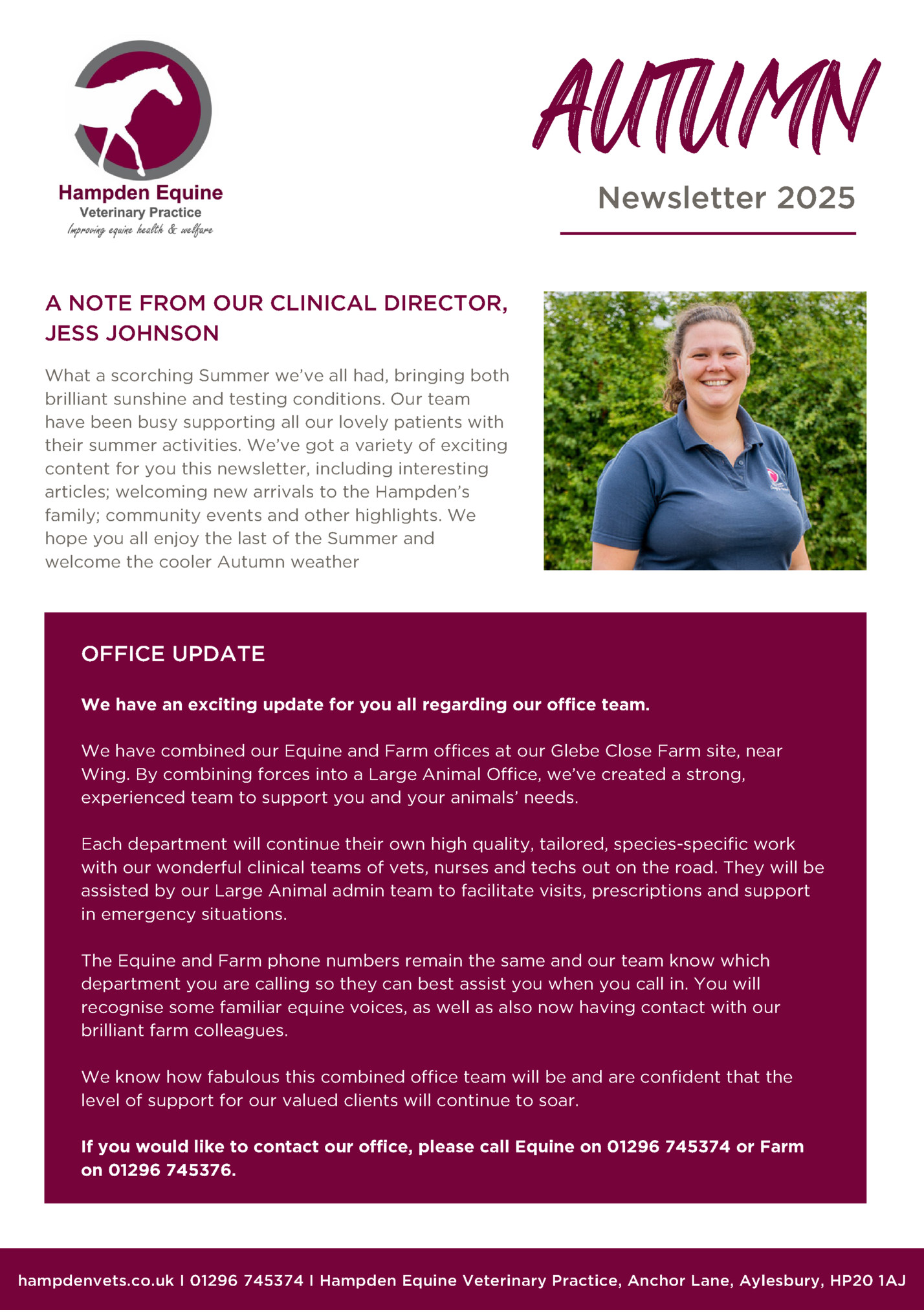
We are absolutely delighted to introduce the newest (and tiniest!) member of the Hampden Equine family, baby Phoebe Wren Perry, born on 17th May. A huge congratulations to Jo, Tim, and proud big brother Milo on their beautiful new arrival. We couldn’t be happier for you all and can’t wait to meet Phoebe for some cuddles very soon! MEDICATION REQUESTS CHARLOTTE AND LAUREN HAVE BEEN OUT INSPIRING YOUNG MINDS Whitchurch combined school held an Independence and Careers week and asked local businesses to come along and talk to the children and share what is involved in the jobs and what exciting futures they could consider. As Vets and Nurses Charlotte and Lauren jumped at the chance to share their experience and thoroughly loved meeting all the children. A reminder we do have several collection points that we can use for you to collect your equine medication from: Barrettstown Equine Clinic HP22 4ES Glebe Close Farm LU7 0LB Small Animal Hospital HP20 1AJ Haddenham Branch HP17 8HH Please remember you need to give at least 3 working days notice on requests. Requests can be taken over the phone on 01296 745376 or online by using the link below: hampdenvets.co.uk/equine/order-equinemedication SHINING SILVER, THANKS TO OUR INCREDIBLE TEAM We’re thrilled to share that we’ve been awarded Silver in the BVA Great Workplaces Awards! This recognition is for our whole team, from equine and farm vets to our small animal crew, whose passion, teamwork and humour make this more than just a workplace. And to our wonderful community, thank you for trusting us with your animals. Here’s to the muddy boots, late-night call-outs, biscuit tin raids and all the moments that make this job so special. hampdenvets.co.uk I 01296 745374 I Hampden Equine Veterinary Practice, Anchor Lane, Aylesbury, HP20 1AJ
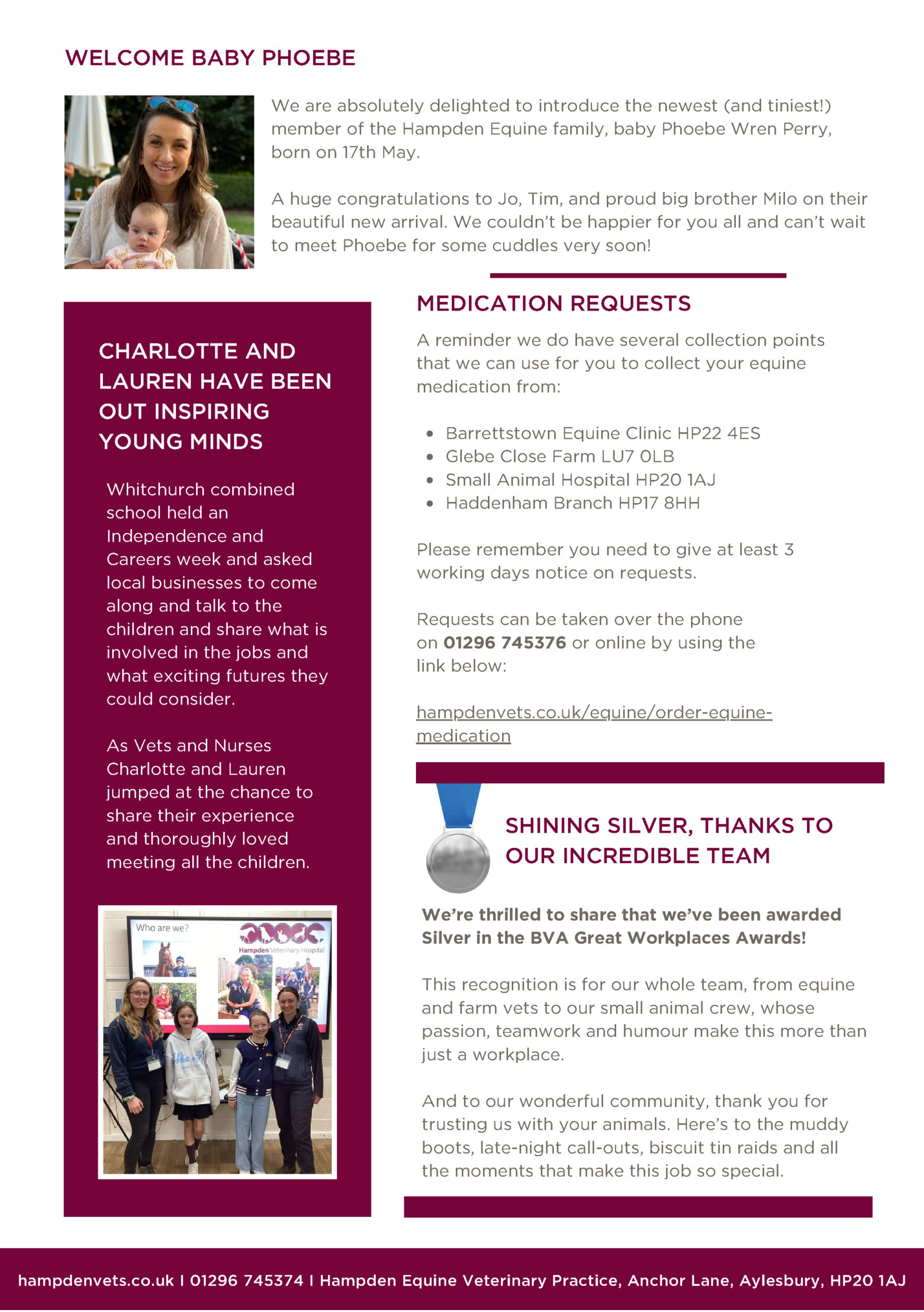
(Pituitary Pars Intermedia Dysfunction), formerly known as equine Cushing’s disease. With naturally rising ACTH levels in the autumn months, this season offers a window of opportunity for accurate testing and early detection. Why test in autumn? ACTH (adrenocorticotropic hormone) levels fluctuate throughout the year, peaking between August and October. Veterinary laboratories provide seasonally adjusted reference ranges during this time, making autumn the most reliable period for detecting abnormal hormone levels that indicate PPID. Treatment and management updates PPID is a progressive condition, but with early diagnosis and proper management, horses can continue to live active, comfortable lives. Treatment typically involves daily administration of pergolide, which helps regulate hormone levels. Regular dental care, farriery, vaccinations, and parasite control are also vital. Signs of PPID to watch for PPID affects horses of all breeds and types, especially those over 15 years old. Early signs can be subtle but are important to catch. Recent updates in management emphasise a more tailored approach, monitoring ACTH levels over time and adjusting doses accordingly, while also considering each horse’s clinical signs and quality of life. Look out for: Delayed or failed coat shedding, or a long, curly coat Lethargy or reduced performance Laminitis, particularly recurring or unexplained cases Weight loss or muscle wastage along the topline Increased drinking and urination Recurrent infections or poor wound healing Take action this autumn If your horse is showing signs or is at risk due to age, now is the time to act. Speak to your vet about scheduling an ACTH test and creating a proactive PPID management plan. Early detection makes all the difference. hampdenvets.co.uk I 01296 745374 I Hampden Equine Veterinary Practice, Anchor Lane, Aylesbury, HP20 1AJ
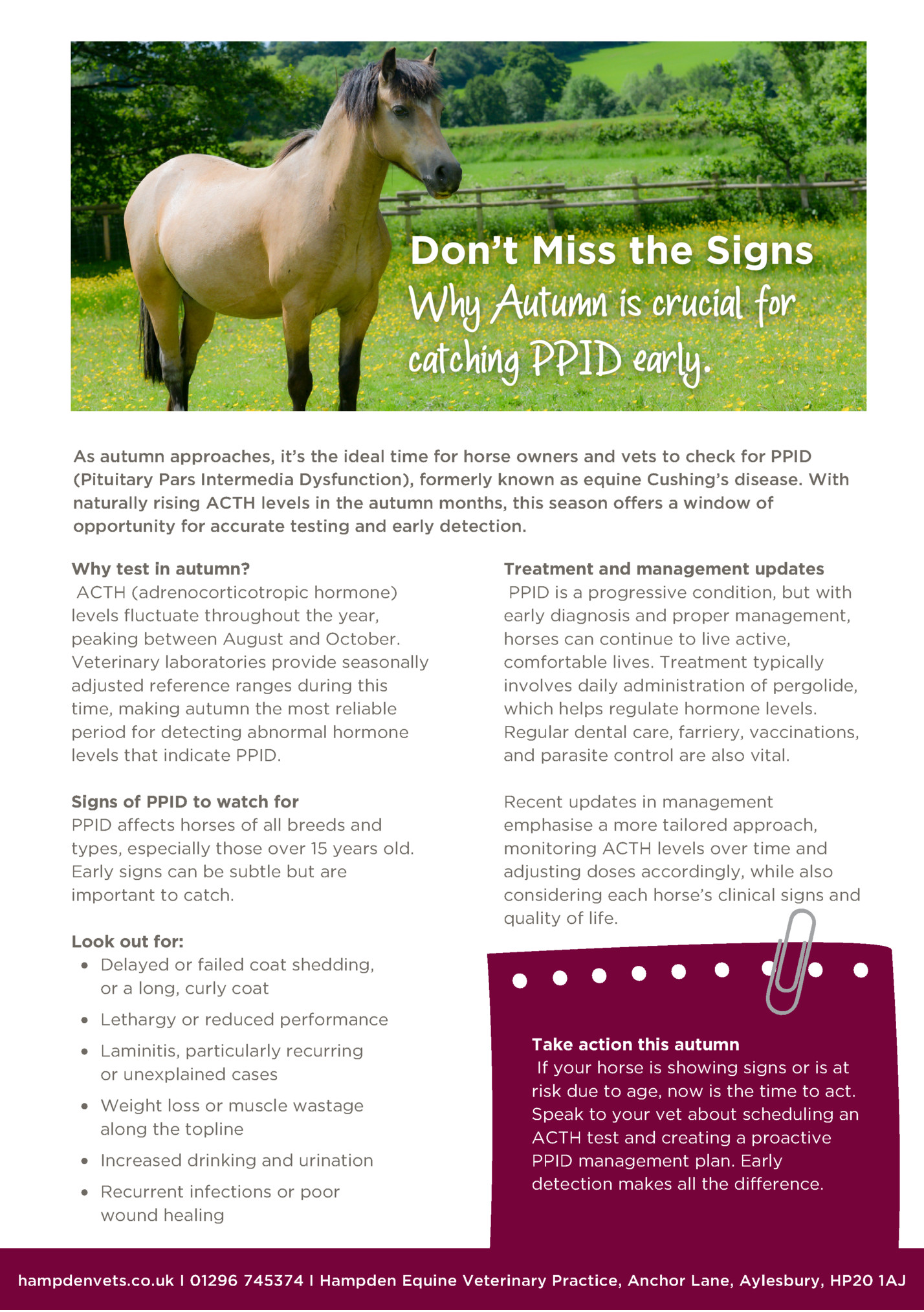
ACUPUNCTURE Is your horse at a healthy weight? As the nights draw in and the temperature drops, managing your horse’s weight becomes even more important. Whether your horse tends to pile on the pounds or struggles to maintain condition, taking a proactive approach in autumn can help ensure a healthier, happier winter. 1. Know your starting point Start with a body condition score (BCS) assessment. Use a weight tape and hands-on checks to get an accurate picture of your horse’s current condition. Look for fat coverage on the ribs, neck, and rump. Document the results so you can monitor changes over time. 2. Adjust the diet early Don’t wait until winter hits to make dietary changes. Horses that are overweight may benefit from reducedcalorie forage and limited access to lush pasture. For underweight horses or those prone to losing condition, consider adding extra fibre-based calories now to build reserves before colder weather increases energy demands. 4. Encourage movement Shorter days and muddy paddocks can mean less turnout and exercise. Find ways to keep your horse moving, turnout in safe winter paddocks, in-hand walks, or indoor schooling can help maintain fitness and support a healthy metabolism. 5. Regular monitoring Continue to weigh-tape and body score every few weeks. It’s much easier to adjust a feeding plan gradually than to play catch-up later in the season. 6. Speak to your vet or nutritionist If you're unsure how to adapt your horse’s diet or if your horse has a medical condition such as PPID or EMS, get tailored advice from your vet or an equine nutritionist. 3. Review rugging and clipping Rugging and clipping can influence how many calories your horse uses to keep warm. Unclipped horses with a natural winter coat often manage fine without heavy rugs, which can help weight management. For older or lean horses, however, rugs can help conserve valuable calories. hampdenvets.co.uk I 01296 745374 I Hampden Equine Veterinary Practice, Anchor Lane, Aylesbury, HP20 1AJ
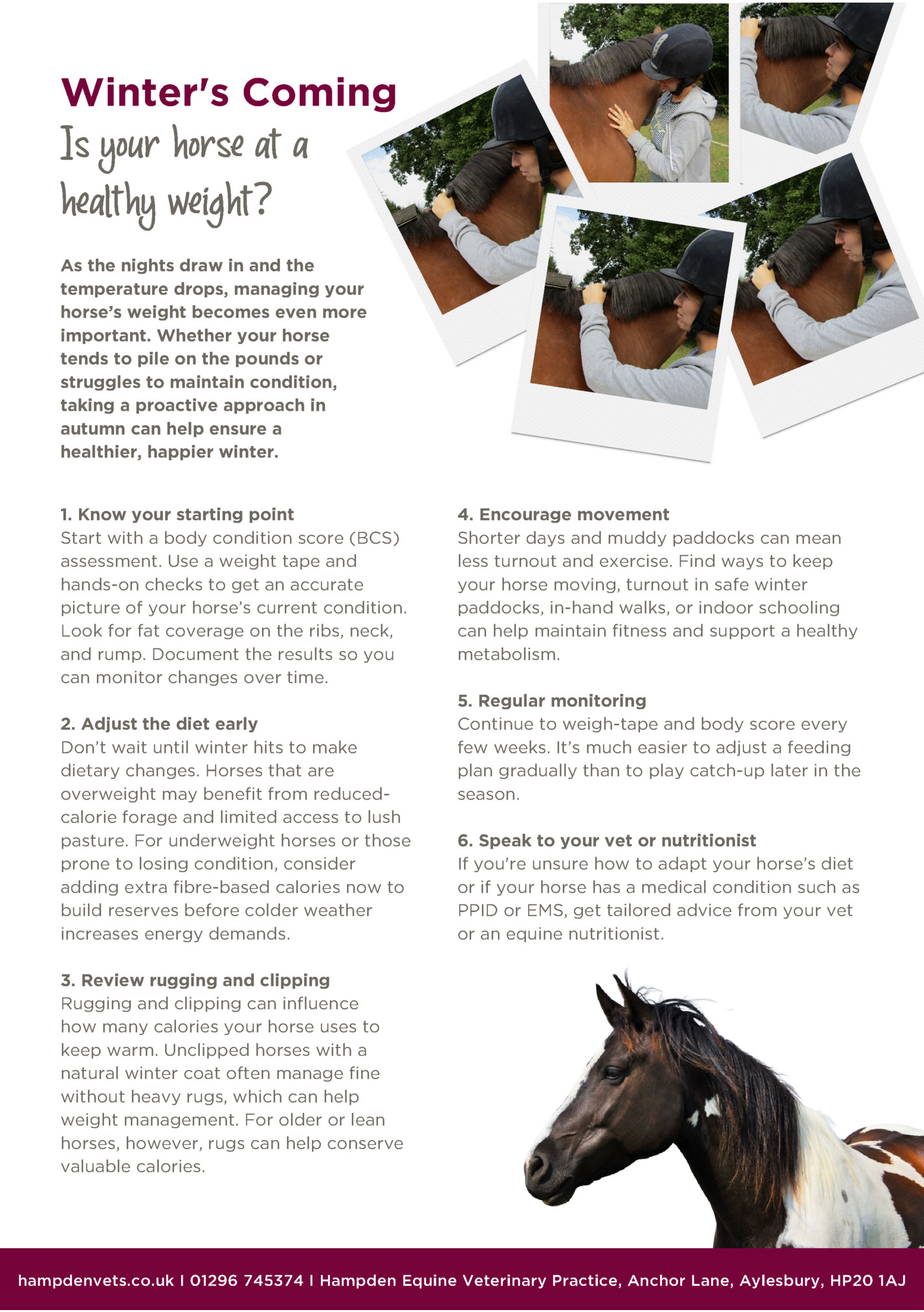
What needs attention? As horse owners, it’s not unusual to find a new bump, lump, or scrape on your horse during your daily check. Horses are masters at finding ways to injure themselves, whether in the stable, field, or during exercise. But how do you know what’s serious and what can wait? And why do some wounds that look minor end up being the most dangerous? This article will guide you through what to monitor, when to call your vet and why small puncture wounds deserve special attention. When to monitor and when to call the vet Monitor: Some issues don’t require immediate veterinary attention but still need a watchful eye. Keep track of any changes in: Small swellings without heat or lameness Mild scrapes or grazes on the skin surface Lumps that aren’t painful or rapidly growing Minor insect bites or stings You can usually manage these with basic first aid and regular checks. Clean any broken skin, apply an appropriate wound cream and monitor for signs of infection such as swelling, heat, or discharge. Call your vet if you notice: Lameness, even if the wound looks minor Swelling that increases quickly or becomes hot and painful A wound near a joint, tendon, or eye Any puncture wound, especially in the sole or lower limb Persistent or sudden-onset lumps that grow, change shape, or cause discomfort Fever, lethargy, or loss of appetite in your horse Wounds with foreign objects embedded (like wood, wire, or thorns) Excessive bleeding or inability to stop bleeding after a few minutes of pressure If in doubt, always err on the side of caution. It’s far better to get advice early than deal with complications later. hampdenvets.co.uk I 01296 745374 I Hampden Equine Veterinary Practice, Anchor Lane, Aylesbury, HP20 1AJ
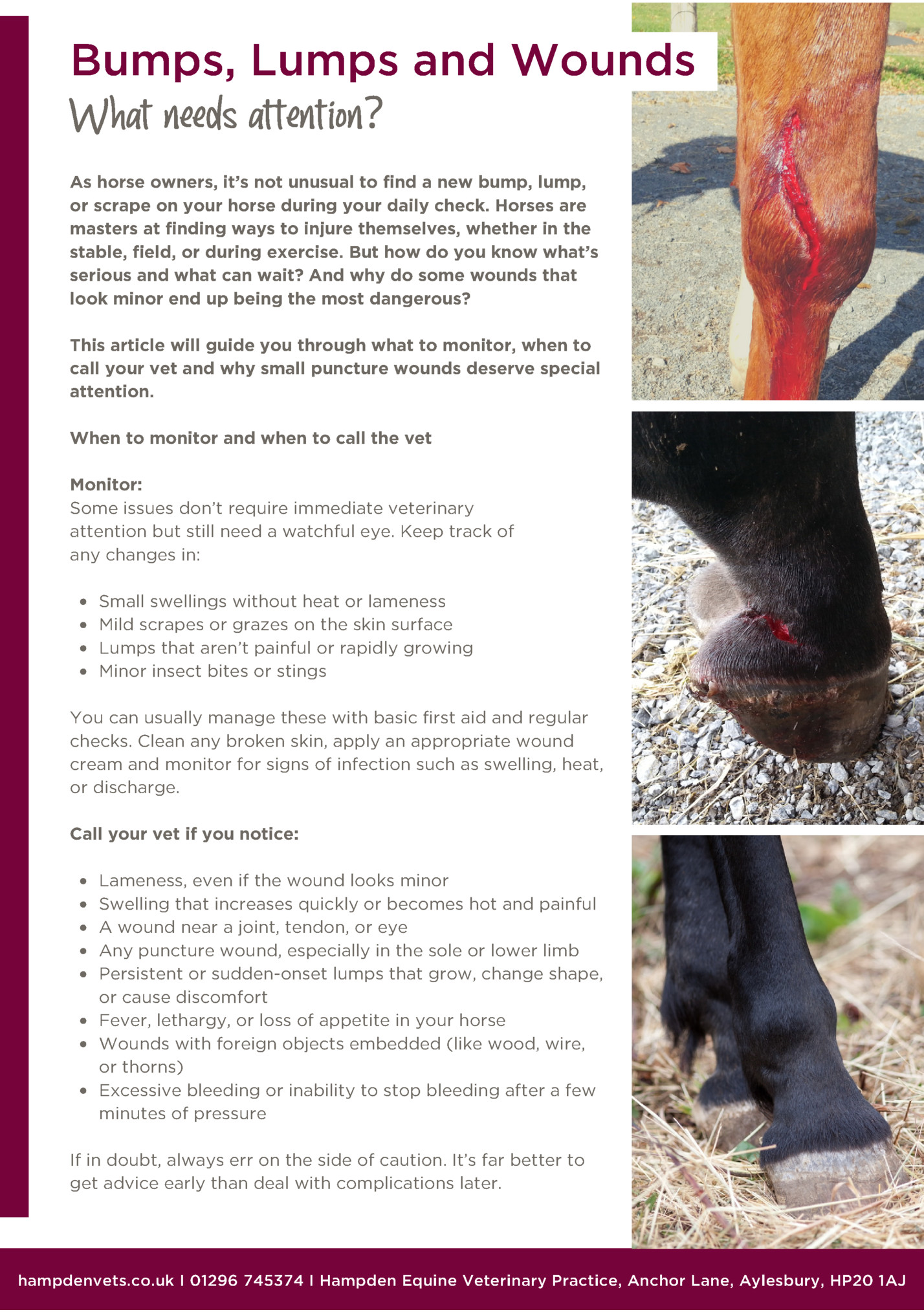
serious than they look Puncture wounds can be deceptively small on the outside, but cause significant damage beneath the surface. These injuries, commonly caused by nails, thorns, or sharp objects, create narrow, deep tracks that trap bacteria and debris inside the body. Why they’re risky: They close quickly on the surface, sealing infection inside Bacteria can reach deep tissues, including tendons, ligaments, and joints There may be little to no bleeding, which reduces natural flushing of contaminants Tetanus risk is high, especially if your horse’s vaccination is not up to date Punctures in the foot, particularly in the sole or frog, are especially dangerous. These can lead to infections in the navicular bursa, tendon sheath, or coffin joint—all serious, potentially life-threatening conditions requiring urgent specialist care. Tips for Managing Wounds Safely Inspect your horse daily, especially limbs, feet and eyes Clean any wound gently with saline or clean water Avoid using hydrogen peroxide or harsh antiseptics, which can delay healing Take clear photos to track progress or share with your vet Check vaccination status, especially for tetanus Don’t bandage deep or puncture wounds without veterinary advice, as this can seal in infection Even a small wound over a joint or tendon sheath can introduce bacteria into the synovial fluid, leading to septic synovitis, which is a true emergency. These cases may require advanced diagnostics, flushing under general anaesthesia, and intensive treatment. In Summary Not every lump or wound is an emergency, but some that look minor can quickly turn serious. Prompt recognition and action can prevent long-term problems or even save your horse’s life. Always trust your instincts, if something doesn’t look or feel right, give your vet a call. When in doubt, check it out. Better safe than sorry. hampdenvets.co.uk I 01296 745374 I Hampden Equine Veterinary Practice, Anchor Lane, Aylesbury, HP20 1AJ
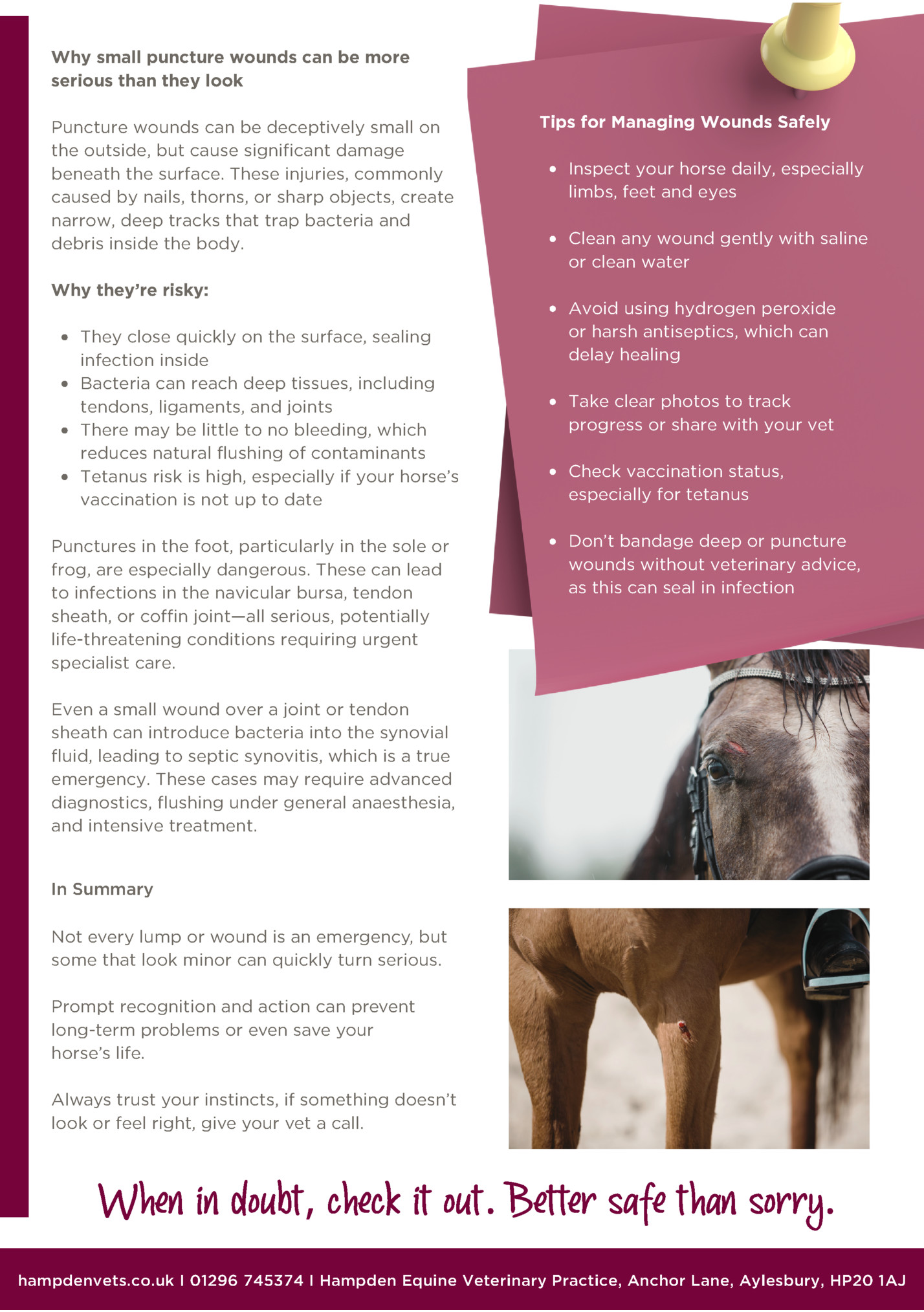
Why it matters more than ever As horses age, their healthcare needs evolve—and dental care becomes increasingly important. Just like in humans, age-related changes in the mouth can lead to discomfort, weight loss, and other health problems if not addressed. Proactive dental care for older horses is essential to ensure their comfort, performance, and quality of life. The ageing equine mouth As horses age, their teeth wear down, increasing the risk of dental problems, especially after age 15. Uneven wear can cause wave or step mouth, affecting chewing. Sharp enamel points may lead to painful ulcers, while loose or missing teeth create gaps that trap food and raise infection risk. Periodontal disease is common in older horses, often caused by chronic food packing. Some horses also experience eruption exhaustion, where teeth stop emerging, making wear-related issues more likely. Spotting dental issues Dental pain in senior horses can be subtle. Signs include weight loss, quidding (dropping chewed hay), bad breath, slow or messy eating, head tilting while eating, or nasal discharge. Early recognition is important to avoid more serious health problems. The vet’s role Dental checks every 6–12 months are essential, especially for older horses. A full exam includes using a speculum and light to inspect teeth and soft tissues, checking for mobility, infection, or unusual wear and taking X-rays if deeper problems are suspected. Vets trained in equine dentistry can also manage complex issues like extractions and advanced gum disease. Feeding and management tips Older horses with dental issues may struggle with hay or grazing. Offering chopped or soaked forage (such as hay cubes or beet pulp) and senior feeds can help. Schedule dental checks before winter when forage changes, as poor chewing can affect digestion and increase the risk of colic or weight loss. A lifetime of comfort Dental care is key to keeping older horses healthy and comfortable. With regular checkups, timely treatment, and dietary support, senior horses can thrive well into their later years. Whether retired or still active, every older horse benefits from a tailored dental care plan, speak to your vet to get started. hampdenvets.co.uk I 01296 745374 I Hampden Equine Veterinary Practice, Anchor Lane, Aylesbury, HP20 1AJ
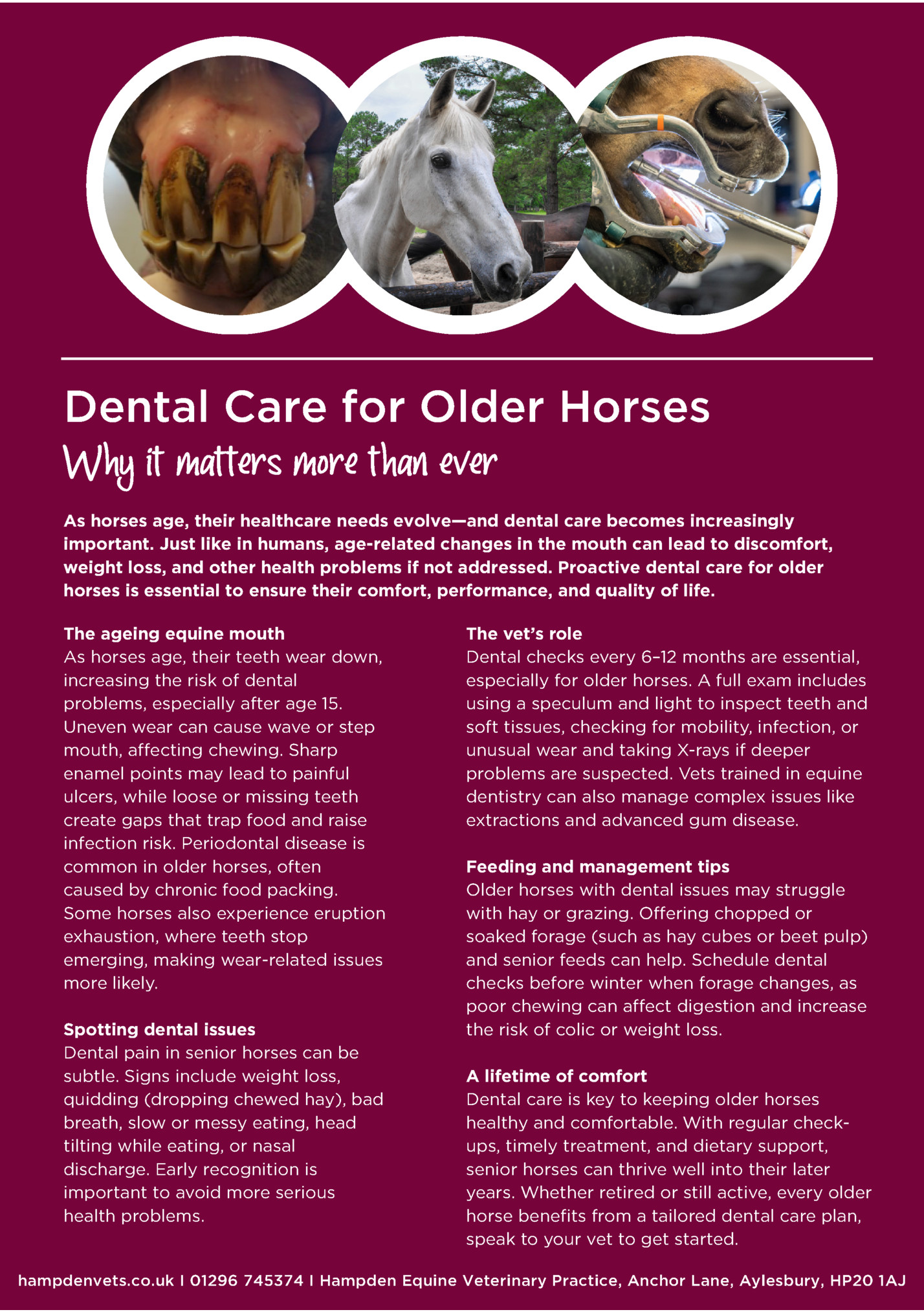
Making sense of equine diagnostics When your horse isn’t quite right, a thorough clinical examination is the first step. But to get to the root of a problem—especially when signs are subtle, complex, or internal—we often rely on diagnostic tools to give us a clearer picture. With a growing array of advanced equipment available, you might wonder: Why do vets choose one tool over another? What’s the difference between them? Here’s a straightforward guide to help demystify the most common diagnostic tools we use in equine veterinary medicine and how we decide which is most appropriate for your horse. Radiography (X-ray) What it shows: Bones and hard tissues Best for: Fractures, arthritis, dental abnormalities, navicular changes, and joint problems Why choose it? X-rays are often the first-line tool for imaging bones. They’re fast, widely available, and relatively affordable. If we suspect a bony issue, like lameness in the lower limb, a suspected fracture, or dental pathology—radiography provides essential structural detail. Ultrasound What it shows: Soft tissue structures like tendons, ligaments, muscles, and some internal organs Best for: Tendon injuries, joint fluid, reproductive exams, abdominal assessments Why choose it? Ultrasound offers real-time imaging of soft tissue, which X-rays can’t provide. It’s often used to assess tendon damage, monitor healing, or guide injections. It’s also used internally (such as for colic assessments or pregnancy scans) to visualise organs noninvasively. Endoscopy What it shows: The inside of airways, stomach, and other internal passages Best for: Respiratory issues, gastric ulcers, poor performance, nasal discharge Why choose it? When horses show signs like coughing, nasal discharge, or poor performance, we may need to see inside their airways or stomach. Endoscopy allows direct visual inspection and even sample collection (e.g., tracheal wash), helping us diagnose conditions like respiratory infections or equine gastric ulcer syndrome (EGUS). hampdenvets.co.uk I 01296 745374 I Hampden Equine Veterinary Practice, Anchor Lane, Aylesbury, HP20 1AJ
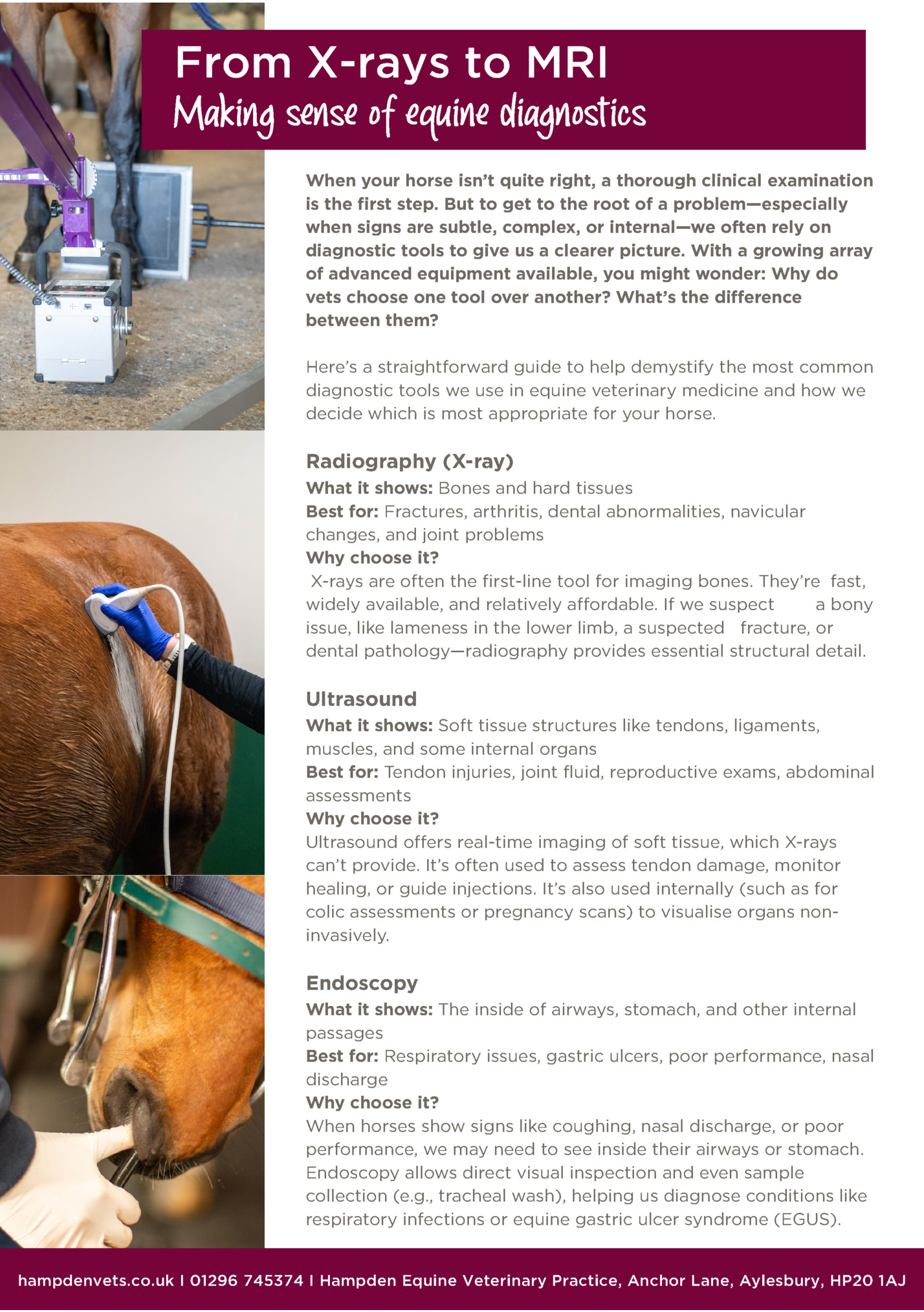
Magnetic Resonance Imaging (MRI) What it shows: Areas of increased bone activity or inflammation Best for: Subtle lameness, pelvic/back pain, complex multi-limb lameness Why choose it? Scintigraphy is particularly helpful when lameness is hard to localise. It can highlight abnormal bone activity even before structural changes are visible on Xray. We often use it when conventional imaging hasn’t revealed a cause, or to investigate upper limbs and the spine, where radiographs are limited. What it shows: Detailed images of both bone and soft tissue, especially in the foot and lower limb Best for: Navicular disease, deep digital flexor tendon injuries, chronic lameness Why choose it? MRI gives unparalleled detail of structures inside the hoof capsule and lower limb. If a horse has persistent lameness that hasn't responded to treatment—or if nerve blocks suggest foot pain but imaging is inconclusive, MRI can provide the missing piece of the puzzle. Computed Tomography (CT) Choosing the right tool: It’s not one-size fits all Each diagnostic tool has strengths and limitations. The choice depends on: What clinical signs the horse is showing Which part of the body is affected How long the problem has been present What previous diagnostics have shown What treatments have already been tried What it shows: Highly detailed crosssectional images of bone and some soft tissue Best for: Head, neck, sinus, and dental issues; complex fractures Why choose it? CT offers exceptional 3D detail, especially useful in the skull, spine, and complex joints. It can detect fractures, infections, or abscesses not visible on standard X-ray. For dental or sinus problems, CT is often the gold standard for diagnosis and surgical planning. Often, a combination of tools gives the most accurate diagnosis. For example, we may start with radiographs and ultrasound, then recommend CT or MRI if more detail is needed, Working together for the best outcome Our practice is equipped with advanced diagnostic technology, but more importantly, we know when to use it. We work closely with owners to tailor the diagnostic approach to each horse, ensuring the best chance of a swift, accurate diagnosis and effective treatment plan. Got questions about your horse’s diagnosis? Contact our team, we’re here to help. hampdenvets.co.uk I 01296 745374 I Hampden Equine Veterinary Practice, Anchor Lane, Aylesbury, HP20 1AJ
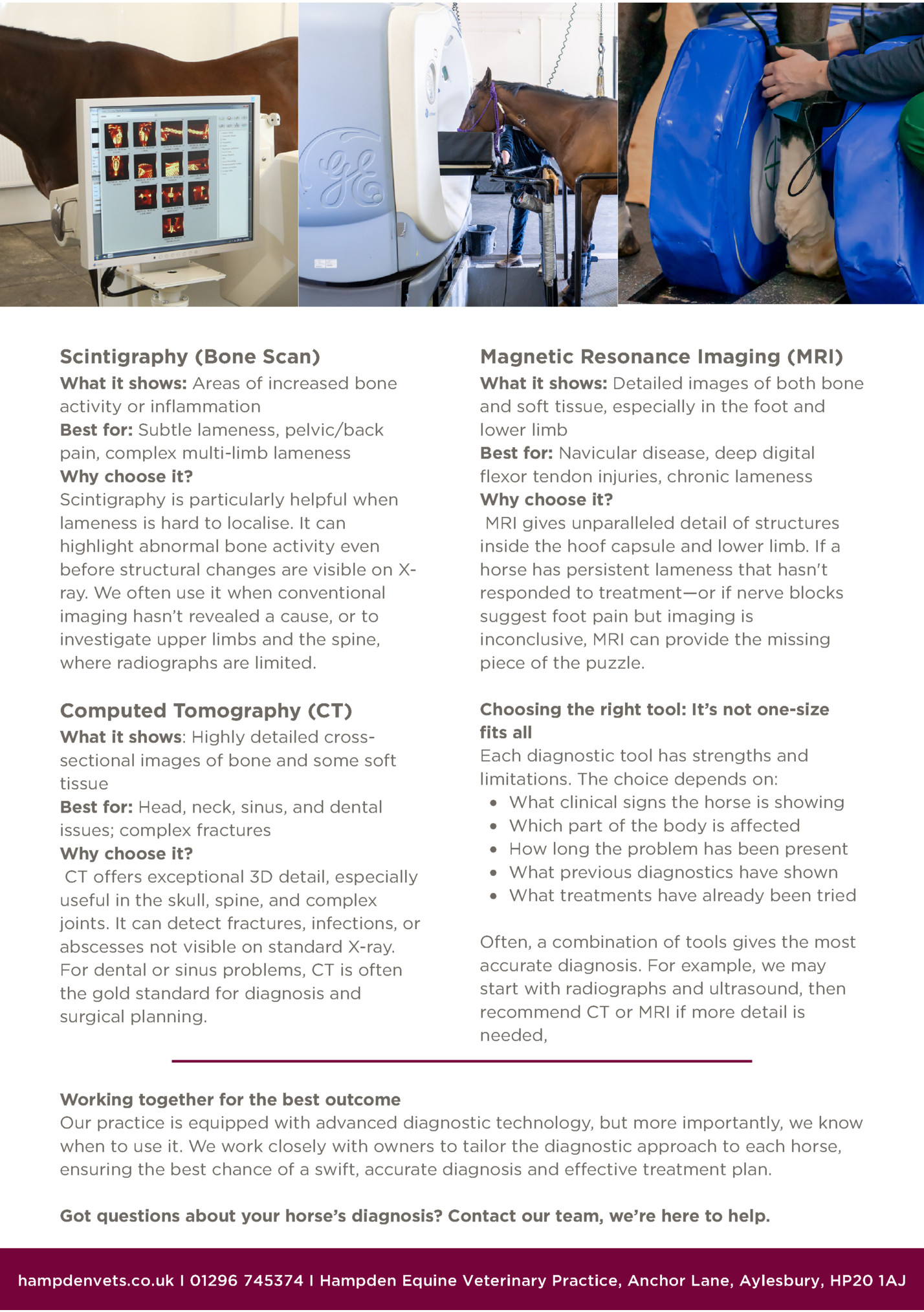
Fleepit Digital © 2021